Table of Contents
If you’re a fan of gourmet seafood dishes and unique desserts, the crab brulee recipe is sure to impress. Combining the savory richness of crab with the sweet, creamy texture of brulee, this seafood dessert is a luxurious twist on the classic French dessert. It brings together the best of both worlds—sweet and savory—creating a sophisticated dish that’s perfect for special occasions or elegant dinner parties.
The seafood dessert recipe offers an unexpected and delightful flavor profile, showcasing the delicate sweetness of crab, paired with a velvety custard and a caramelised sugar topping. Whether you’re looking to elevate your next gathering or impress your guests with something truly unique, crab brulee is a must-try culinary experience. Get ready to indulge in the ultimate seafood dessert that combines artistry with flavour!
What Is Crab Brulee?
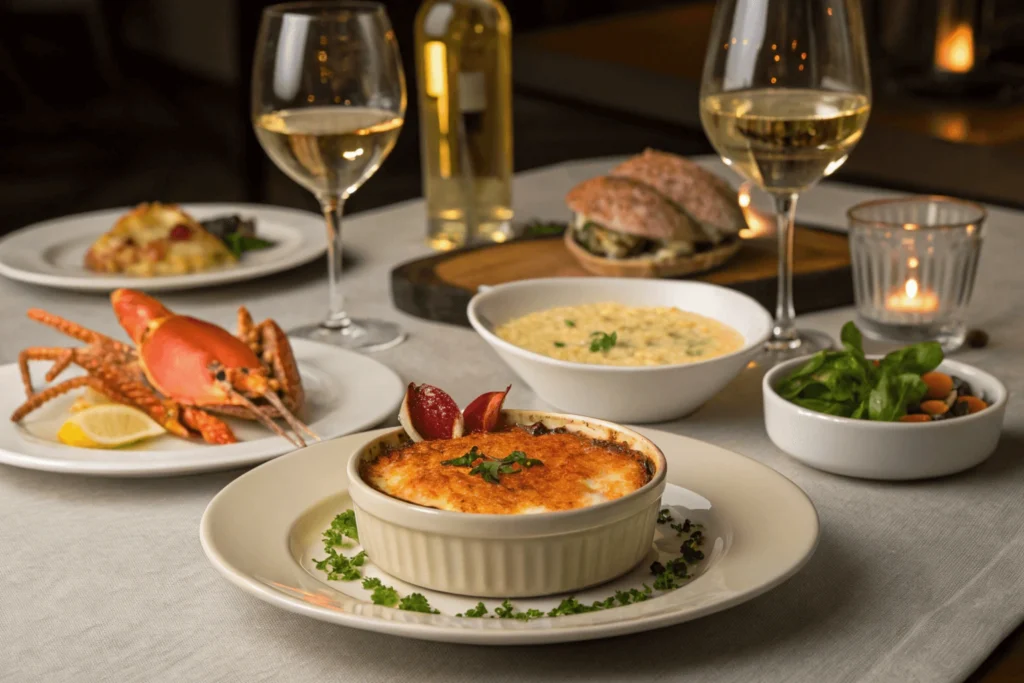
Definition of Crab Brulee and Its Place in Gourmet Cuisine
Crab brulee is an innovative and luxurious twist on the classic crème brûlée. Unlike its traditional sweet counterpart, which is typically made with cream, sugar, and vanilla, crab brulee takes a savory approach by incorporating tender, sweet crab meat into a rich custard base. The dish is topped with a layer of caramelized sugar, creating a perfect balance between savory, creamy, and slightly sweet flavors.
This dish is often considered part of the fine dining experience, where chefs enjoy experimenting with bold and unexpected flavor combinations. Crab brulee represents the intersection of two culinary worlds: seafood and dessert, making it a standout option for those looking to enjoy a sophisticated, unconventional treat.
How It Differs from Traditional Sweet Brulee Recipes
The key distinction between crab brulee and a traditional sweet brulee lies in the core ingredients and flavor profile:
- Traditional Sweet Brulee: Typically made with heavy cream, eggs, sugar, and vanilla, this dessert is rich and indulgent, with a smooth custard and a caramelized sugar topping. The flavor is overwhelmingly sweet with subtle hints of vanilla.
- Crab Brulee: Instead of the sugar and vanilla, crab brulee replaces these ingredients with seafood—specifically crab meat, often paired with a creamy custard made from heavy cream, butter, and eggs. The savory sweetness of the crab adds a unique flavor profile, and the caramelized sugar topping contrasts nicely with the richness of the custard, offering a perfect balance of flavors that is completely different from a traditional brulee.
While traditional brulee is typically served as a dessert, crab brulee is an elegant seafood appetizer or entrée that can act as a sophisticated first course in a gourmet meal. The transformation of the classic brulee into something savory makes it both surprising and delightful for those who love experimenting with culinary innovation.
Overview of the Dish’s History and Where It’s Commonly Served
The crème brûlée has its origins in French cuisine, and it has been a staple of French restaurants and fine dining for centuries. It is believed to date back to the 17th century, and its evolution into crab brulee is part of the modern trend of fusing classic recipes with contemporary twists. Seafood brulees, including crab brulee, have grown in popularity in coastal cities and fine dining establishments around the world, especially in regions known for their fresh seafood like the Pacific Northwest, New England, and parts of France and Italy.
Crab brulee is commonly served in high-end restaurants, luxury seafood restaurants, and at gourmet catering events. It is often featured in tasting menus where chefs push the boundaries of traditional culinary styles, offering patrons a chance to experience unique dishes that blend the unexpected. This dish also frequently appears as part of celebratory meals, such as holiday feasts, anniversaries, or even as a surprising offering at wedding receptions.
With its sophisticated presentation and complex flavors, crab brulee continues to captivate the culinary world, representing both innovation and elegance in modern cuisine.
Essential Ingredients for Crab Brulee
To create the perfect crab brulee, you’ll need to carefully select your ingredients to achieve the ideal balance of flavors and textures. Let’s dive into the essential components that make this seafood dessert both decadent and memorable.
Crab: The Star Ingredient
The crab is the centerpiece of this dish, and selecting the right type is crucial for achieving the best flavor and texture. The two most popular options are:
- Dungeness Crab: Known for its sweet, tender meat, Dungeness crab is a favorite in seafood dishes and works beautifully in crab brulee. Its subtle sweetness complements the rich custard base without overwhelming the dish. The soft, flaky texture also blends well when incorporated into the creamy custard.
- King Crab: If you’re aiming for a more indulgent touch, king crab is an excellent choice. With its large, meaty claws and slightly more robust flavor, king crab lends a luxurious quality to the brulee. Its meat is firmer than Dungeness, providing a satisfying bite when paired with the smooth custard.
When preparing the crab, it’s essential to remove all shells and cartilage, ensuring that the meat is perfectly shredded and ready to be incorporated into the custard.
Cream and Butter: A Rich, Creamy Base
The custard that holds the crab meat together relies heavily on heavy cream and butter to create a smooth, rich base. These two ingredients are responsible for giving the brulee its signature velvety texture.
- Heavy Cream: The richness of heavy cream forms the foundation of the custard, adding a luscious, silky mouthfeel. It helps bind the eggs and other ingredients together while allowing the flavors to meld beautifully. A generous amount of cream ensures that the brulee is decadent without becoming too heavy.
- Butter: A small amount of butter contributes additional creaminess and a slight savory flavor that enhances the overall richness of the dish. It helps to balance the sweetness of the caramelized sugar on top, creating a harmonious contrast of flavors.
Together, the cream and butter create a luxurious custard that perfectly complements the sweetness of the crab.
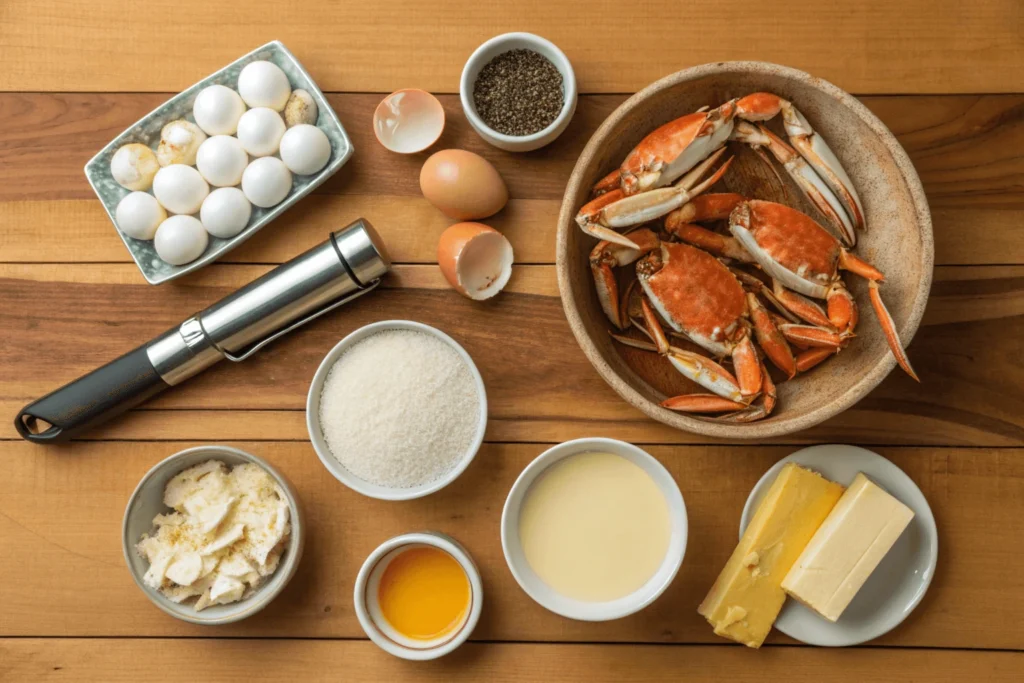
Eggs: Achieving the Custard-Like Texture
Eggs play a vital role in achieving the smooth, custard-like texture that is characteristic of brulee. The proteins in eggs act as a binding agent, giving the custard its structure and creamy consistency.
- Egg Yolks: The yolks provide richness and a deep golden color to the custard, contributing to its silky smooth texture. They help the custard set properly during baking, giving it that perfect balance between creamy and firm.
- Egg Whites: Although the focus is on the yolks, you can also use the egg whites in the brulee base to lighten the texture slightly, but be careful not to overbeat them, as they can create an unwanted airy texture.
The key to achieving the perfect custard is gently tempering the eggs with the hot cream to avoid curdling, ensuring that the mixture is silky and smooth.
Vanilla Bean and Brown Sugar: Flavor Depth and Caramelization
The vanilla bean and brown sugar are essential for providing depth of flavor and the signature caramelized finish that defines brulee.
- Vanilla Bean: Using a vanilla bean instead of vanilla extract adds a deeper, more complex flavor to the custard. The small black seeds of the vanilla bean infuse the custard with a rich, aromatic essence that elevates the overall taste. It’s an important addition to balance the sweetness of the sugar and enhance the natural flavor of the crab.
- Brown Sugar: The topping of brown sugar is what gives the brulee its characteristic caramelized crust. Brown sugar has a slight molasses flavor that provides a rich sweetness, which, when brûléed with a culinary torch, creates a beautiful, crunchy contrast to the creamy custard. The caramelized sugar also adds a touch of sophistication, making each bite a delightful balance of flavors.
Together, these ingredients ensure that your crab brulee has the perfect balance of sweetness, depth, and texture, with each component contributing to a harmonious, indulgent dish.
Step-by-Step Guide to Making Crab Brulee
Making crab brulee is an art that combines delicate seafood with a smooth, velvety custard and a perfectly caramelized sugar top. This step-by-step guide will help you prepare this elegant dish from start to finish, ensuring each component is executed to perfection.
Preparing and Cooking the Crab Meat
The first step in making crab brulee is preparing the crab meat, which forms the base of the dish. Here’s how to do it right:
- Choosing the Crab: Select fresh, high-quality crab meat. Dungeness crab or king crab are ideal because of their sweet, tender meat. You can use pre-cooked crab or, if you prefer, cook it yourself. If you’re using fresh crab, steam or boil it until it’s fully cooked—typically about 8-10 minutes.
- Extracting the Meat: Once the crab has cooled, carefully remove the meat from the shell. You want to ensure the meat remains in large chunks to create a rich texture when added to the custard. Avoid using shredded or overly fine crab meat, as it can lose the tender, juicy quality you’re after.
- Seasoning: Lightly season the crab with a pinch of salt, pepper, and a dash of lemon juice to enhance its natural sweetness. Keep the seasoning minimal, as the brulee base will contribute plenty of flavor.
Making the Custard Base with Heavy Cream, Eggs, and Butter
The custard base is the soul of your crab brulee, providing a rich, creamy texture that complements the sweet crab meat. Here’s how to make it:
- Whisking the Eggs: In a mixing bowl, whisk together eggs and egg yolks. The eggs provide the structure and silky smooth texture needed for the brulee. For best results, use large eggs and separate the yolks carefully.
- Heating the Cream and Butter: In a saucepan, heat heavy cream and butter over medium heat. Stir occasionally until the butter is fully melted and the cream begins to simmer. Be careful not to boil it. This step ensures the mixture is rich and smooth.
- Tempering the Eggs: Gradually add a small amount of the hot cream mixture into the beaten eggs, whisking constantly. This process, called tempering, prevents the eggs from scrambling when they come into contact with the hot cream. Once the eggs are tempered, slowly pour the egg mixture back into the saucepan with the rest of the cream, stirring constantly to combine.
- Flavoring the Custard: Add a hint of vanilla bean or vanilla extract to the custard mixture for a subtle sweet aroma. You can also infuse the custard with other flavors like a pinch of nutmeg or a splash of cognac for added depth.
- Straining the Custard: To ensure your custard is perfectly smooth, strain the mixture through a fine-mesh sieve to remove any bits of egg that may have curdled. This step results in a silky custard that’s ideal for brulee.
Combining the Crab with the Creamy Base and Transferring to Brulee Dishes
Now that you have both the crab meat and the custard base ready, it’s time to assemble the dish:
- Mixing the Crab and Custard: Gently fold the seasoned crab meat into the custard mixture. Be careful not to break the crab into too small pieces; the large chunks add texture and a luxurious bite to the brulee. Make sure the crab is evenly spread throughout the custard.
- Filling the Brulee Dishes: Spoon the crab and custard mixture into individual brulee dishes or ramekins. Make sure to fill each dish evenly, leaving a small gap at the top to allow for the sugar layer later. Gently tap the dishes on the counter to remove any air bubbles for a smooth, even surface.
- Baking: Place the filled ramekins in a large baking dish and add hot water to the outer dish, creating a water bath (also known as a bain-marie). This helps regulate the temperature and ensures that the custard cooks evenly. Bake in a preheated oven at around 325°F (160°C) for 35-40 minutes, or until the custard is set but still slightly wobbly in the center.
How to Properly Caramelize the Sugar Using a Culinary Torch
The final touch in creating the perfect crab brulee is the caramelized sugar topping, which adds a satisfying crunch and beautiful golden color.
- Adding the Sugar: Once the crab brulees are fully baked and have cooled to room temperature, sprinkle a thin, even layer of brown sugar over the top of each custard. Use a fine sieve to distribute the sugar evenly, ensuring no lumps or excess sugar form in one area.
- Using the Culinary Torch: To achieve the signature brulee effect, use a culinary torch to melt and caramelize the sugar. Hold the torch about 4-6 inches above the surface and move it in small circles, allowing the sugar to melt and bubble up. Continue until the entire surface has an even, golden-brown color. Be careful not to burn the sugar, as this can result in a bitter taste.
- Finishing Touch: After caramelizing, let the brulee rest for a few minutes. The sugar will harden into a crisp, glass-like layer, ready to be cracked open with a spoon.
By following these steps, you’ll create a perfectly balanced and visually stunning crab brulee that’s sure to wow your guests with its rich flavor and elegant presentation. Enjoy the process, and don’t be afraid to experiment with different seasonings or flavor combinations!
Tips for Perfecting Your Crab Brulee
Making a flawless crab brulee requires attention to detail in every step, from seasoning the crab to ensuring the custard reaches the perfect texture. Here are some expert tips to help you create an unforgettable dish:
How to Season the Crab for Optimal Flavor Without Overpowering the Dish
The seasoning of the crab is crucial to ensure it enhances the delicate sweetness of the meat without overshadowing the creamy custard base. Here are some tips:
- Simple Seasoning: Use mild seasoning, such as a touch of sea salt and freshly ground black pepper, to bring out the natural sweetness of the crab.
- Citrus Zest: A little lemon zest can add a refreshing brightness to the crab, balancing the richness of the custard without overpowering it.
- Fresh Herbs: Fresh herbs like parsley, dill, or tarragon can complement the crab’s flavor, but be sure to use them sparingly to maintain the dish’s elegance.
- Avoid Strong Spices: Avoid heavy spices like chili powder or cumin, which could mask the delicate crab flavor and distract from the brulee’s balance.
Ensuring the Right Texture for the Custard—Tips for Smooth, Silky Results
The custard is the heart of the crab brulee, and achieving the right texture is key to its success. Here’s how to ensure a smooth, silky custard:
- Slow and Steady Cooking: When making the custard, cook it over low heat to prevent curdling. High heat can cause the eggs to scramble, ruining the smooth consistency.
- Strain the Custard: After mixing the eggs, cream, and seasonings, strain the custard through a fine-mesh sieve to remove any curdles or impurities. This ensures a silky-smooth texture.
- Consistency Check: To check the custard’s consistency, dip a spoon into the mixture—if it coats the back of the spoon and holds a line when you run your finger through it, it’s ready for use.
The Best Tools to Use, Such as a Brulee Torch for That Perfect Finish
The right tools are essential for perfecting crab brulee, especially when it comes to achieving that signature caramelized top. Consider using these tools:
- Brulee Torch: A culinary torch is the best tool for caramelizing the sugar on top of your brulee. It gives you precise control over the amount of heat applied, ensuring an even golden-brown crust without overcooking the custard.
- Ramekins: Use oven-safe ramekins for baking the crab brulee. These should be shallow enough for the custard to set evenly but deep enough to hold the crab and custard mixture without spilling.
- Sifter or Fine-Mesh Strainer: When adding the brown sugar to the top of the custard, use a fine sifter to ensure an even distribution, which helps achieve that flawless caramelization.
How to Store and Reheat Crab Brulee Without Compromising Quality
Crab brulee is best served fresh, but if you need to store or reheat leftovers, follow these tips to maintain its flavor and texture:
- Storing: Once prepared, store crab brulee in the refrigerator in an airtight container. The custard can last for up to 1-2 days, but avoid storing it with the caramelized sugar top. The sugar will lose its crispness over time.
- Reheating: To reheat, gently warm the custard in a low-temperature oven (around 250°F or 120°C) for 10-15 minutes until it’s warm throughout. Avoid reheating in the microwave, as it can cause the custard to become grainy or overcooked.
- Re-crisping the Sugar Top: If the caramelized sugar has softened, use your brulee torch to lightly re-crisp the top before serving. This will restore the perfect crunchy finish and maintain the dish’s elegance.
By following these expert tips, you can perfect your crab brulee recipe and ensure that every bite is a delicious blend of savory and sweet, with a smooth, velvety custard and a perfectly caramelized sugar topping.
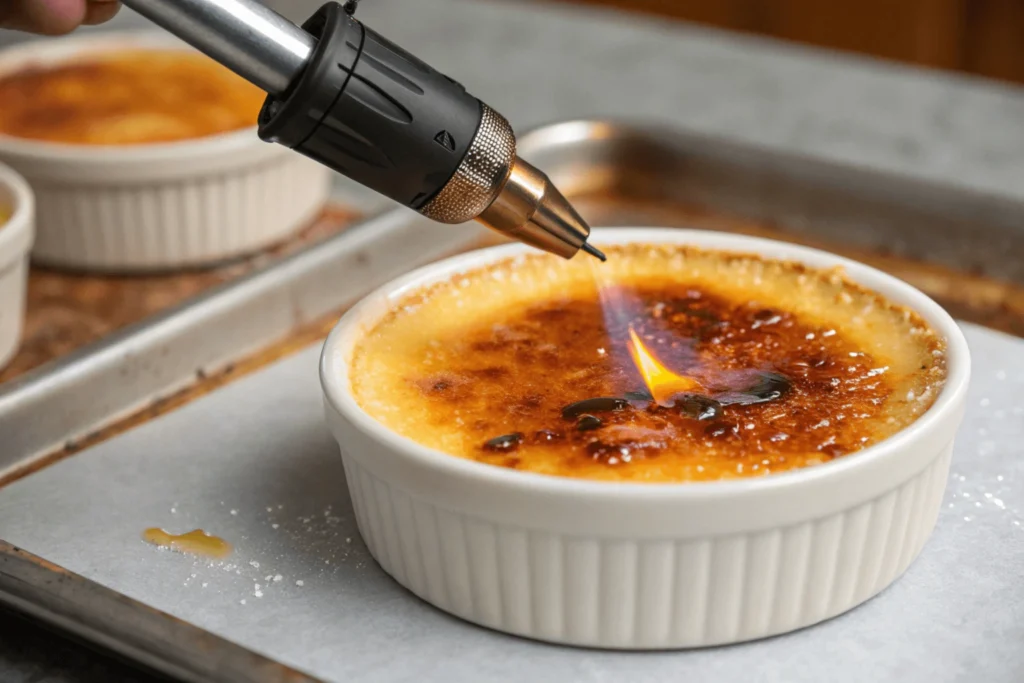
Why You Should Try Crab Brulee for Your Next Special Occasion
Crab brulee offers an elegant and sophisticated twist on the classic dessert, perfect for impressing guests at your next event. If you’re looking for more inspiration on creating memorable meals, check out this guide to creating the perfect gourmet seafood dinner.
The Elegance and Sophistication of Serving Crab Brulee as a Dessert
Crab brulee isn’t your typical dessert—it’s a dish that radiates elegance and sophistication. Serving this unique seafood dessert instantly elevates any meal, making it the perfect choice for upscale events, fine dining experiences, or intimate gatherings. The contrast between the rich, creamy custard and the delicate sweetness of the crab adds a refined touch, while the beautiful golden caramelized sugar top gives it a visually stunning finish. As a dessert, it’s both a conversation starter and a memorable culinary experience, showcasing your creativity and attention to detail.
Whether you’re hosting a formal dinner party, celebrating a special occasion, or just treating yourself to a gourmet meal at home, crab brulee adds that wow factor. Its unexpected pairing of sweet and savory flavors is bound to leave guests talking long after the last bite.
How It Can Impress Guests with Its Unique Flavor Profile and Presentation
What makes crab brulee truly stand out is its unexpected combination of flavors. Most desserts are either sweet or savory, but this dish breaks the mold by blending the natural sweetness of crab with a luscious custard base and a crispy caramelized sugar top. The contrast between the rich, savory crab and the creamy, slightly sweet custard creates a flavor profile that is both intriguing and satisfying. The brulee’s slightly crunchy top adds an extra texture element, making every bite a delightful experience.
The presentation also plays a key role in impressing guests. Serving crab brulee in small ramekins or elegant serving dishes adds an extra layer of refinement. Whether topped with a sprig of fresh herbs or garnished with a delicate sprinkle of sea salt, the dish will look as sophisticated as it tastes, creating a visually stunning treat to accompany your gourmet meal.
A Versatile Dish: Serving Crab Brulee as Part of a Gourmet Seafood Meal
Crab brulee isn’t just a dessert; it can be an integral part of a gourmet seafood feast. Serving this dish as the grand finale to a seafood-focused menu will impress your guests with its versatility and originality. You can pair it with a range of other seafood dishes such as lobster tail, scallops, or a fresh seafood salad, creating a memorable multi-course meal. The savory notes of crab in the brulee make it a great complement to other seafood flavors, offering a refreshing contrast without overpowering the palate.
If you’re hosting a full seafood dinner, crab brulee also provides an unexpected twist that ties together the flavors of the evening. Its creamy texture and delicate flavor will perfectly balance out richer seafood dishes, allowing each course to shine while leaving your guests craving more.
Suggestions for Pairing Wine or Sides with Crab Brulee
To complete the gourmet experience, pair your crab brulee with a carefully chosen wine or side dish. Here are some suggestions to enhance your meal:
- Side Dishes:
- Light Seafood Salad: A fresh seafood salad with lemon vinaigrette provides a crisp, light contrast to the richness of the crab brulee, keeping the meal balanced.
- Roasted Vegetables: Serve roasted vegetables like asparagus or a medley of root vegetables. The slightly smoky, earthy flavors will enhance the natural sweetness of the crab.
- Crusty Bread: A warm, crusty baguette or artisan bread can also be served on the side to complement the flavors and textures, making it a more substantial course if desired.
Conclusion
Crab brulee is a truly unique and sophisticated dish that blends the best of savory and sweet, making it the perfect choice for your next special occasion. With its rich, creamy texture, delicate crab flavor, and the elegant presentation of a caramelized sugar top, this seafood dessert will undoubtedly impress your guests and elevate your dining experience. Whether served as part of a gourmet seafood meal or as the grand finale to a formal dinner, crab brulee offers a refreshing twist on classic dessert ideas.
From its versatility in pairing with wines and sides to its ability to stand out as a show-stopping dish, crab brulee promises to leave a lasting impression on anyone who tries it. So, why not indulge in this exquisite dessert at your next event? Try making it yourself, and don’t forget to share your experience or any creative variations in the comments—let’s celebrate the art of fine dining together!

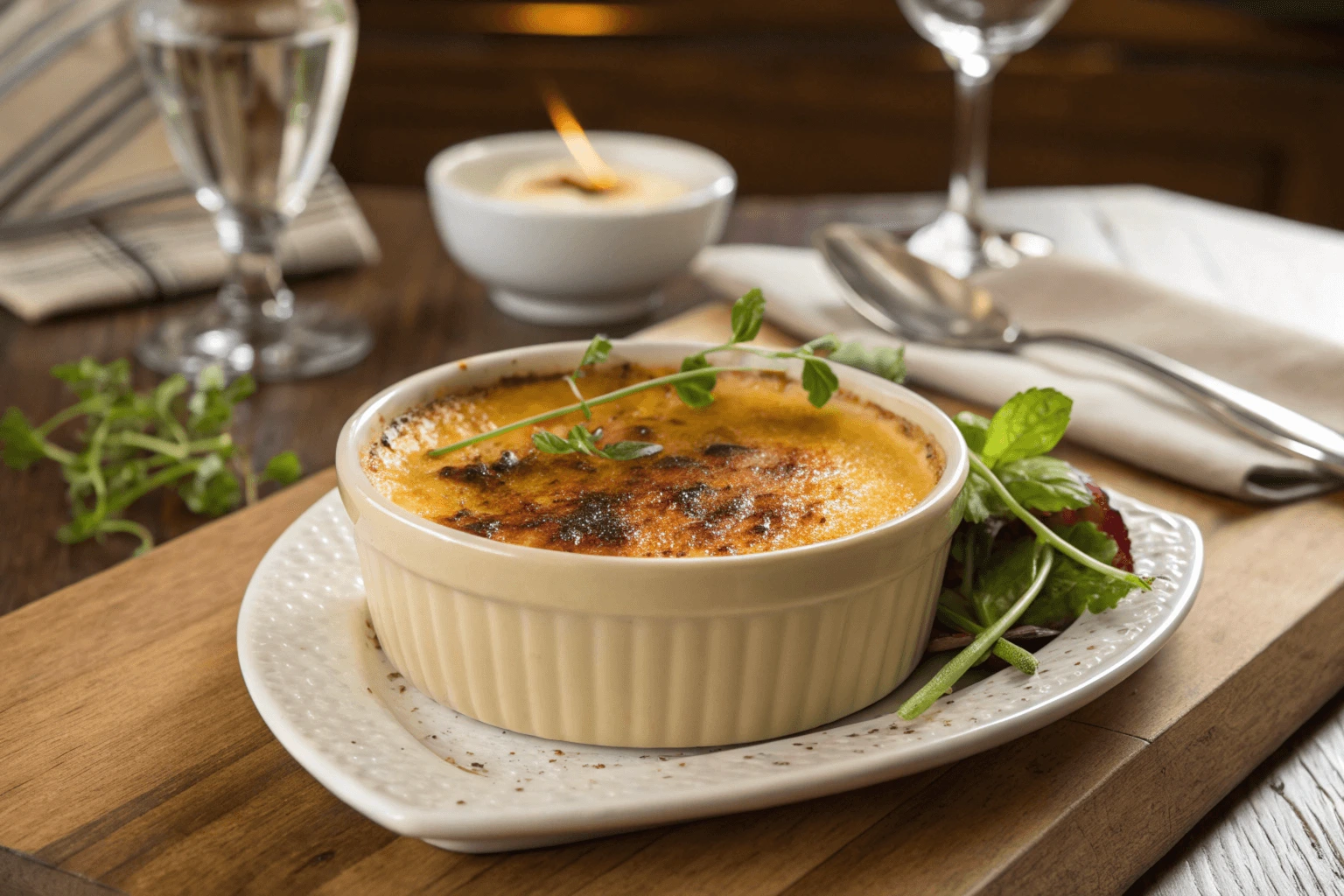
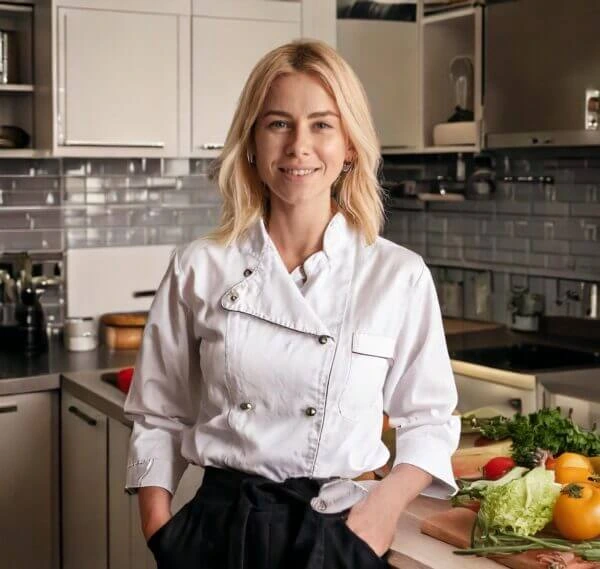
3 thoughts on “Crab Brulee Recipe: How To Make This Elegant Seafood Dessert”
Comments are closed.